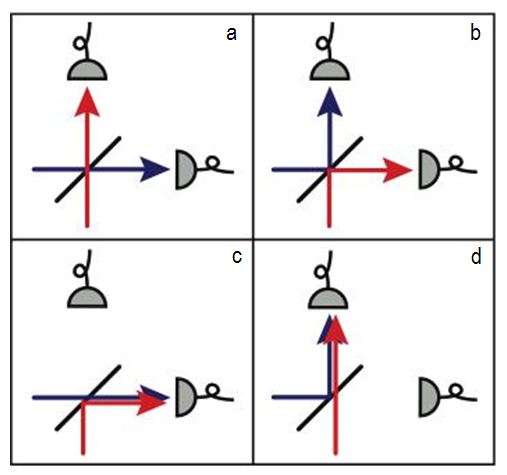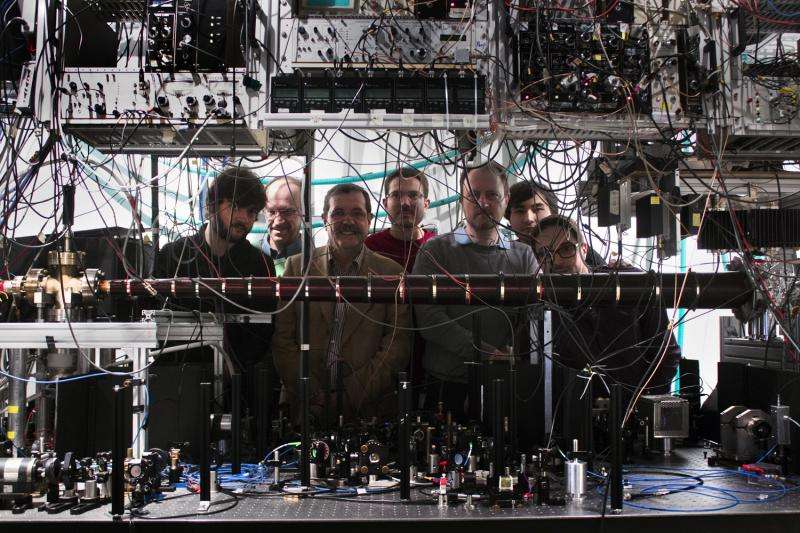Quantum interference links the fate of two atoms

For the first time, physicists from the CNRS and Université Paris-Sud at the Laboratoire Charles Fabry (CNRS/Institut d'Optique Graduate School) have achieved interference between two separate atoms: when sent towards the opposite sides of a semi-transparent mirror, the two atoms always emerge together. This type of experiment, which was carried out with photons around thirty years ago, had so far been impossible to perform with matter, due to the extreme difficulty of creating and manipulating pairs of indistinguishable atoms. The work is published in the journal Nature dated 2 April 2015.
The notion of indistinguishable particles, mentioned as early as 1924 by Bose and Einstein, lies at the heart of some of the most perplexing features of quantum mechanics. One such emblematic feature, observed experimentally nearly 30 years ago by Hong, Ou and Mandel, involves photons and a semi-transparent mirror (when a photon is sent towards either side of the mirror, it has a fifty percent chance of passing through it and the same percentage chance of being reflected). If two identical photons are sent towards opposite sides of the mirror, they can be seen to emerge from one side or the other, but always together. In other words, it appears impossible for the two photons to go their own separate ways.
Now, for the first time, physicists at the Laboratoire Charles Fabry have demonstrated this phenomenon with particles of matter, namely helium-4 atoms, instead of particles of light. By combining pairs of atoms on the equivalent (for matter) of a semi-transparent mirror, the researchers observed that when two identical atoms arrive at the same time they always emerge together, just as photons do. This result is the irrefutable signature of destructive quantum interference: the process in which two atoms are simultaneously reflected, and the one in which they are simultaneously transmitted, cancel each other out.
The main obstacle that the researchers managed to overcome was that of creating pairs of indistinguishable atoms and manipulating them. To do this, they first produced a Bose-Einstein condensate containing around 100,000 atoms of helium-4. They succeeded in controlling collisions between the particles so as to produce pairs of indistinguishable atoms, which emerged from this very cold gas at an average rate of one every 30 seconds. The team then manipulated the atoms using laser beams in order to achieve the equivalent of the optical setup in the experiment that Hong, Ou and Mandel performed with photons. To characterize the effect of interference, the researchers staggered the moment of arrival of the two atoms at opposite sides of the mirror. After tens of hours of recording, they were able to verify that, when the two arrivals are separated by more than about a hundred microseconds, each atom goes its own way, whereas when arrivals are closer together they tend to emerge from the same side. The effect is at a maximum when the atoms arrive simultaneously.

As well as confirming a surprising prediction of quantum mechanics, the experiment demonstrates the tremendous progress achieved in recent years in controlling sources of atoms at the quantum scale. Thanks to the extremely sophisticated manipulation of pairs of atoms, this work demonstrates their potential for application in the field of quantum information, which consists in using the specific characteristics of quantum physics for more efficient processing and more secure communication of information.
More information:
"Atomic Hong-Ou-Mandel experiment" Nature, 2 April 2015. DOI: 10.1038/nature14331.
www.nature.com/nature/journal/ … ull/nature14331.html
Journal information: Nature
Provided by CNRS





















